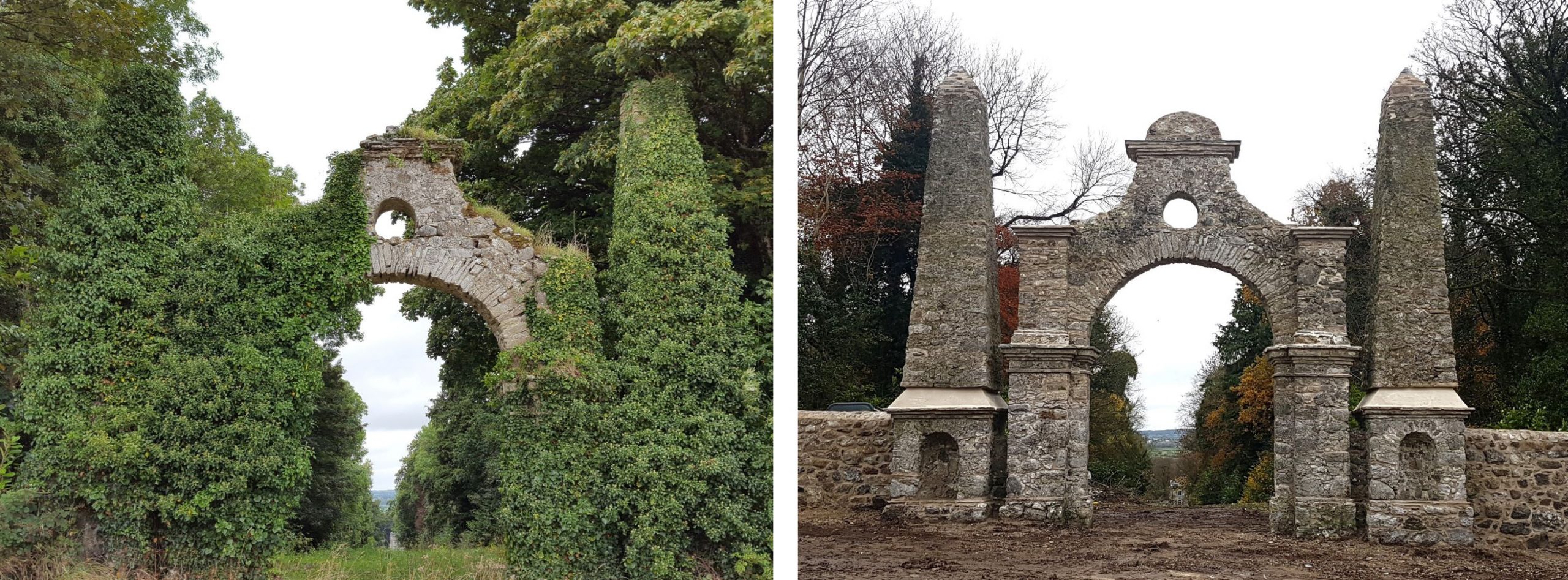Gloster Arch, Co. Offaly
Published in Gems of Architecture, Issue 4 (July/August 2020), Volume 28BY RACHEL MCKENNA
Gloster House in County Offaly was the home of the Lloyd family for over three centuries, beginning in 1639, when Trevor Lloyd married Margaret, the sole heiress of landholder Francis Medhop, and ending with the sale of the estate by Major E.T.T. Lloyd in 1958. The union of Medhop Lloyd and Hannah Lovett in 1696 had unexpected consequences for the architecture of County Offaly when their son, Trevor, set about remodelling Gloster in the early eighteenth century. He appears to have availed of the expertise of his first cousin, Sir Edward Lovett Pearce, and Gloster is described by Maurice Craig as one of the ‘candidates for buildings in some way connected to Pearce’.

No expense was spared on the house or the surrounding grounds, but Trevor did not get to enjoy the fruits of his labours for long; John Wesley, visiting in 1749, remarked on the ‘beautiful seat built by an Englishman who had scarcely finished his house and laid out his gardens when he was called to his everlasting home’.
High among the architectural treasures of the estate—indeed, of the county—is the folly standing majestically on rising ground closing the vista from the dining room. Described by Mark Bence-Jones as ‘without doubt by Pearce’, the folly is unashamedly architectural, a classical stage set providing a theatrical flourish with its proscenium-like arch framing two distinct tableaux—tree-lined formal terraces looking back to the house, the untamed landscape beyond.
On approaching the folly, its symmetry of form and sophisticated detailing are fully revealed. A small oculus pierces the curved gable above the arch and is finished with a segment-topped cornice. Gently tapering obelisks—a device first employed by Pearce at Stillorgan, Co. Dublin—stand on niched pedestals on either side. Sweeping walls extend back into trees so that the line between the man-made and the natural is blurred. Today the folly presents a somewhat rustic appearance, its rubble stone construction exposed to the elements, with only fragments of its original coat of lime.
Nature almost succeeded in reclaiming the folly and by 2018 it was covered in ivy, obscuring its fine detailing and damaging its stonework. A decision was made to conserve the folly and funding was sourced from the Built Heritage Investment Scheme, the Apollo Trust, Creative Ireland and the Follies Trust, along with owner funding.
The first phase of works saw the ivy carefully removed and the roots treated to prevent regrowth. A detailed photographic record was made so that any stonework that might become dislodged could be faithfully reassembled. The folly was stabilised and the stonework was repointed with a lime mortar colour-matched to the original. The removal of the ivy revealed the full extent of the sweeping walls for the first time in decades, along with the extent of the damage to some sections, and their repair was completed as part of the conservation project.
Rachel McKenna is Senior Executive Architect, Offaly County Council, and author of Flights of fancy: follies, families and demesnes in Offaly (2017). Series based on the National Inventory of Architectural Heritage’s ‘building of the month’, www.buildingsofireland.ie.
















